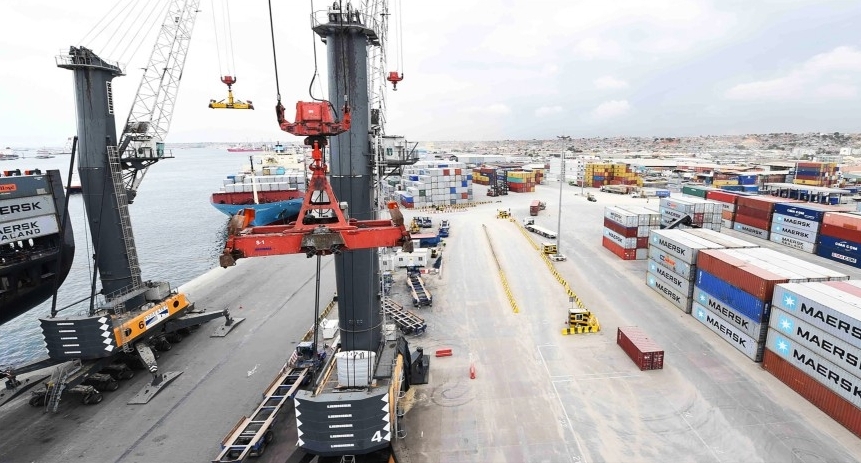Angola, country that could become logistics hub for southern Africa
The Republic of Angola ranks 159 out of 160 countries in the 2018 Logistics Performance Index.

The Republic of Angola ranks 159 out of 160 countries in the 2018 Logistics Performance Index (LPI). However, Angola seems like a country with a very bright logistics future as it has enough resources to build them. It holds opportunities to become a logistics hub due to how it is positioned in the Atlantic Ocean and the presence of mineral-rich landlocked countries around it.
Angola is situated on the western coast of southern Africa. It is surrounded by Namibia in the south, Zambia in the east, the Democratic Republic of the Congo and the Republic of Congo in the north and the Atlantic Ocean in the west.
According to the International Monetary Fund, Angola is the fifth largest economy in sub-Saharan Africa after it fell down two positions to Kenya and Ethiopia very recently. The country’s economy depends heavily on its oil reserves with 97 percent of total merchandise exports coming from it.
Train to Trade II, an EU-UNCTAD joint programme for Angola that also envisions to promoting sustainable transport and trade logistics systems, corridor and cluster-based approaches, notes that “Overdependence on a single export item (oil) has also discouraged the country from incorporating into global value chains and participating more fully in the export of manufactured goods and value-added services.â€
With the steady reduction of global oil prices since 2014, Angola is going through an economic recession and Covid-19 only accelerated it. As it is slowly diversifying its economy to industries other than oil, logistics infrastructure will play a crucial role and the government knows it very well.
Alexandre Henrotte, chief executive officer, Angola, Agility, said, “Angola definitely has several advantages in terms of logistics compared to other African countries, including the coastline and logistics corridors for the DRC and Zambia. Logistics profitability is largely driven by the mature oil and gas industry infrastructure that Angola has substantially developed the last 30 years. Other industries with potential such as agriculture, diamonds, and fast-moving consumer goods are now an important focus, as well as the potential profitability of the logistics industry.â€
Ports
With 1,600 kilometres of Atlantic Ocean coastline, Angola has at least five major seaports that connect it to the rest of the world. The Port of Luanda in its capital city is the biggest of all with an average throughput of 802,112 TEUs between 2010 and 2019. The port handles exports like petroleum, diamonds, fisheries and iron ore. Lobito port is the second-largest port in the country, with heavy Chinese investment.
Angola’s minister of transport Ricardo D’Abreu in September 2020 laid out his government’s intension to develop the port facilities in the country as transhipment logistic hubs for regional African commodities coordinated by Benguela Railway what connects the port city of Lobito, Benguela Province, Angola in the west and Tenke, Democratic Republic of Congo in the east. It is worth noting that all seaports in the country are used for only internal needs.
Henrotte of Agility said, “Shipping is well established and all key sea carriers have a presence in Angola, mainly in terms of containerized and carrier container vessels. Angola’s terminals are semi-privately managed in Luanda. In Lobito and Namibe, they are not yet privatized. The Cabinda exclave of Angola into DRC and Congo has started the new port and now - through reinvestment - is set to be one of the most significant ports of southern Africa from the Atlantic Ocean side.â€
Railway
Angola has a total of 2645 kilometre of the railway network across the country, however, most of the rail lines were destroyed by the civil war. The government of Angola carried out major refurbishment and restoration projects throughout these lines since 2007.
The 1,344-km Benguela Railway was inaugurated in March 2018 by moving 1,000 tonnes of Manganese from DRC to Lobito port. The railway that already carries 16 million tonnes per annum is expected to extend till Zambia in the east to help these landlocked countries to transport minerals.
The other two railway networks in Angola are the 445-kmLuanda Railway Line that connects the capital city with Malange, also called as the northern corridor and the 860-km Moçâmedes Railway Line between Namibe and Menongue also called as the southern corridor.
.jpg)
During a weekly briefing in October 2020, the secretary of state for planning, Milton Reis, revealed the country’s plan to extend the Luanda railroad by 1000-km to the mineral-rich Kananga town in the Democratic Republic of the Congo under public-private partnership model. The government also plans to extend the southern corridor to the copper belt of Zambia for the transport minerals from the region.
The extensions of the northern and southern corridors are potential game-changers as they could move the minerals from these regions of DRC and Zambia out to the world in a much cheaper and faster mode.
Henrotte, informed, “Emerging logistics hubs will be close to borders, allowing the exchange of goods with our neighbouring countries and throughout the SADC region. They will also follow the railway development from the Angolan coast to the landlocked African countries by three axes that have already been developed. The Angolan government is about to create the conditions to sustain the hubs by preparing tenders for the terminals and concessions, and free zones to attract industries to invest in Angola; this was voted through just last week. The first line is Luanda – Dondo – Malanje. The second line is Lobito – Huambo – Luena – Luau. The third line is Namibe – Lubango – Menongue.â€
Roads
Angola has a road network of around 76,000 kilometres. While only 18 percent is paved, a good share of the secondary and tertiary road network is impassable during rainy seasons. When passable, average speed is less than 20 km/h, rendering the commercialization of agriculture products a challenging task. It takes 49–531 days to export or import goods, among the longest times in Africa.
Logistics profitability is largely driven by the mature oil and gas industry infrastructure that Angola has substantially developed the last 30 years.
Alexandre Henrotte, CEO, Angola, Agility
In a report titled ‘Angola road sector public expenditure review’ published in June 2020, World Bank noted, “Road access is particularly problematic for firms outside Luanda. Regional road corridors are underdeveloped, and the poor road condition increases transport costs and hampers Angola’s value proposition as the regional transport gateway for Southern DRC and landlocked Zambia and Botswana,†it continued.
In September 2020, the ministry of construction and public works contracted $335 million to a consortium of Angolan and Portuguese companies for projects that includes a contract to rehabilitate the National Road (EN) 230 and to build a new Saurimo Bypass by the beginning of 2022. Rehabilitation of the EN 230 has huge economic benefits as it connects Luanda with the agricultural products and mining activities in Bengo, Kwanza Norte, Malange, Lunda Norte and Lunda Sul provinces of the country.
Henrotte, noted, “Angola’s road and rail infrastructure are still under development and are aimed at creating connections into the southern Africa zone. Customs administration is also now implemented at border posts to support the smooth movement of cargo across borders with clear procedures and formalities. This is the case for DRC - Luvo border post (by road), and Namibia - Santa Clara border post (by road). On the east, DRC is served by rail (the Luau border post), but the Zambia rail connection is yet to be achieved. Progress, alignment and achievement of these corridors depends also on the governments of these neighbouring countries.â€
Air cargo
With 11 major airports in the country, Quatro de Fevereiro International Airport in the capital city of Luanda is the main international airport and the gateway for air freight in the country.
Angola is building the New Luanda International Airport 40 kilometres south to Luanda and is planned as an alternative to the existing Quatro de Fevereiro International Airport. Constructing in a 1,324-hectare land, the government wants this airport to become the aviation hub for western Africa.
As the pandemic has severely impacted the air transport industry, 2020 has been a very difficult year for all African carriers including the national airline of Angola, TAAG.
Henrotte, informed, “TAAG is now focusing on developing intra-regional flights through the southern African Zone. Cargo aircraft operate jointly with other cargo operators from Europe and the Americas.â€


